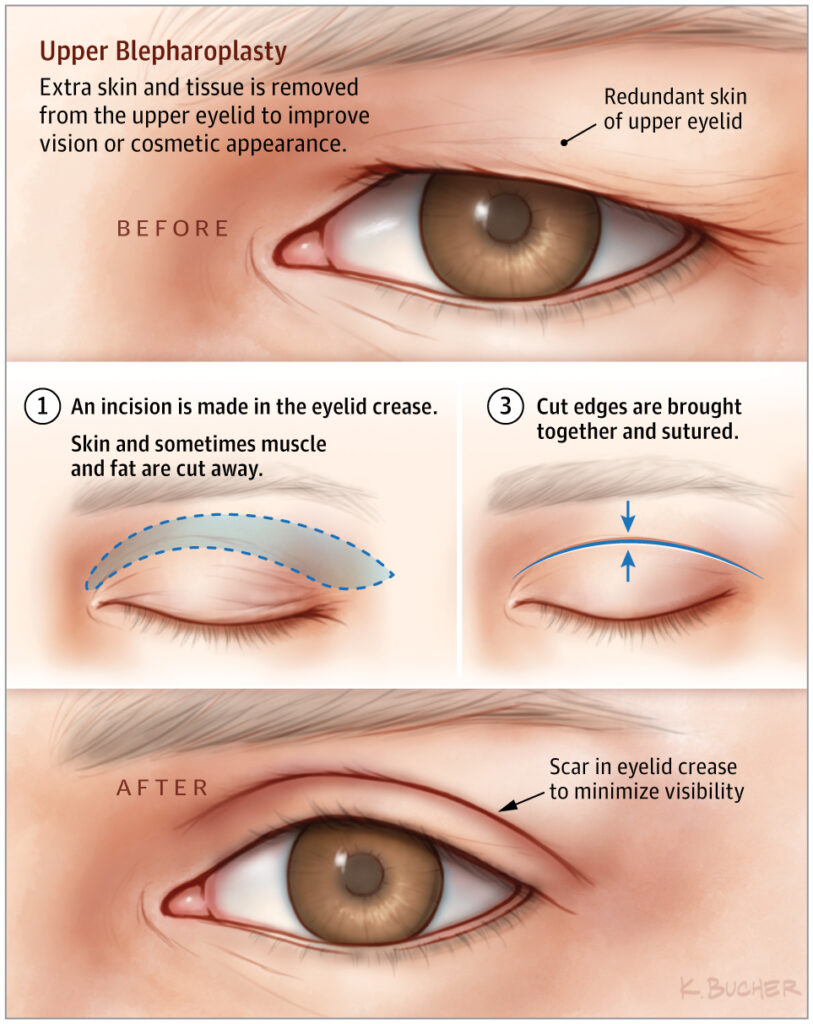General Information:
As we age there are several anatomic changes occurring in the face:
- Downward descent of soft tissues lead to deeper lines
- Loss of elasticity results sagging and puffiness around the eyes
- Loss of facial fat leads to deflation and hollows
- Changes in the color and texture of the skin
In upper eyelid surgery the upper eyelid skin is removed to create a clean upper eyelid crease and reveal the skin above the eyelashes. The amount of skin removed varies between individuals to create an eye that looks natural and rejuvenated.
Upper eyelid surgery can be performed alone or in combination with other facial procedures like lower eyelid surgery, and brow lifts.
Who is a candidate for an upper eyelid lift?
An upper eyelid lift is great for patients of any age who have excess skin on their eyelids. These changes may be caused by stress, muscle activity, or inherited conditions like low heavy-set brows. The average age range for someone undergoing eyelid surgery is generally 40-70 years old. Important factors include:
- you are physically healthy
- you have a positive outlook and realistic goals for what can be accomplished through surgery
What are my treatment options?
The surgical treatment for excess upper eyelid skin is a procedure called a blepharoplasty.
Blepharoplasty: an ellipse of skin is removed from both upper eyelids to eliminate the excess skin. At the same time the puffiness in the inner corner of the upper eyelid (nasal fat pad) may be sculpted or repositioned to create a smooth contour of the upper eyelid
Care must be taken to ensure the upper eyelid is not over sculpted or “hollowed” which can result in an “over done” look.
What are the risks?
It is important to have a detailed discussion on the risks associated with surgery as they can vary between the type of surgery performed.
In general the risks include but are not limited to the anesthesia risk, bleeding, infection, inflammation, scarring, changes in skin sensation, possible need for additional surgery.
It’s important that you address all your questions directly with your surgeon.
What can be expected afterwards?
In general, initial wound healing may take 7-10 days. Sutures will be removed when deemed appropriate by your surgeon.
Most patients return to work after 7-10 days.
At this point you may appear presentable; however, additional healing will continue over the course of several weeks as the swelling subsides, and incision lines continue to heal.
It may take several months for you to completely recover from surgery.
Following your physician’s instructions is essential to the success of your surgery.
Why choose an Oculofacial Plastic Surgeon?
Oculofacial plastic surgeons are the only type of surgeons that have training in both surgery of the eyes and soft tissues of the face. When having procedures performed around your eyes the utmost care must be taken in order to preserve the delicate function of the eyes and their surrounding tissues. There are both aesthetic and functional implications. That is why we recommend having your surgery performed by an expert – an Oculofacial Plastic Surgeon.

